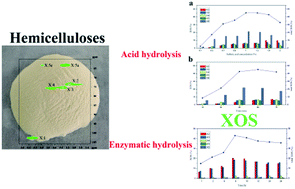Evaluation of xylooligosaccharide production from residual hemicelluloses of dissolving pulp by acid and enzymatic hydrolysis†
Abstract
Xylooligosaccharides (XOS) are useful food and pharmaceutical additives, which can be produced from various xylans. However, the XOS prepared from lignocellulosic materials are difficult to purify due to the complexity of the degradation products. Thus, hemicelluloses with a high-purity will be the preferred feedstock for XOS production. In this work, acid hydrolysis and enzymatic hydrolysis were applied to prepare XOS from the residual hemicelluloses of the dissolving pulp. The results showed that the highest XOS yield (45.18%) obtained from the acid hydrolysis was achieved with 1% sulfuric acid at 120 °C for 60 min, and xylohexaose accounted for 47% of the XOS. For enzymatic hydrolysis, under optimal conditions, the highest XOS yield of 42.96% was observed, and xylobiose and xylotriose comprised 90.5% of the XOS. It is suggested that the distribution of the XOS could be controlled significantly according to the enzymatic or acid hydrolysis conditions used.

- This article is part of the themed collection: Editors' collection: Food Engineering, Science, Technology, and Nutrition


 Please wait while we load your content...
Please wait while we load your content...